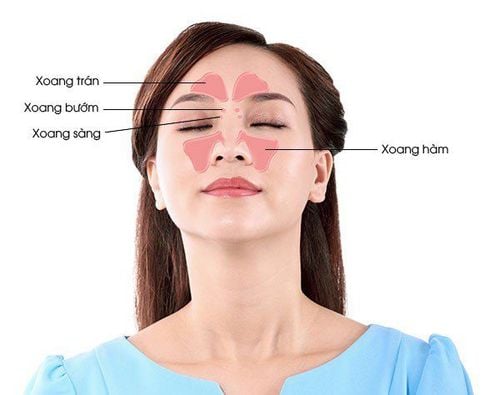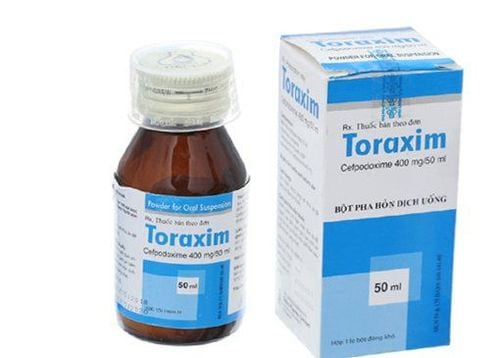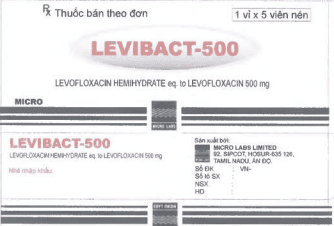This is an automatically translated article.
The article was professionally consulted by Specialist Doctor I Le Van Quang - Ear, Nose Throat Doctor - Department of General Surgery - Vinmec Nha Trang International General Hospital. BSCKI. Le Van Quang is an expert in the field of ENT with 15 years of experience.Sinusitis is a very common disease, due to many causes, depending on the type of sinusitis and the cause of the disease, the doctor will have an appropriate treatment regimen.
1. What is sinusitis?
Sinus anatomy: In the skull, there are many bones grafted together, the bones are mostly hollow bones. Sinuses are cavities located in the skull bone and are named with the name of that bone, the lumen of the sinuses is lined by the lining of the sinuses, the lining of the sinuses has the same structure as the respiratory mucosa, the secretions from the mucosa All of the sinuses empty into the nasal cavity through small openings (called the nasopharynx).
Structure of the sinuses is divided into two groups including:
Anterior sinus group: Including the maxillary sinus, anterior ethmoid sinus, frontal sinus, these sinuses surround the eye socket. This group of sinuses secretes fluid and all pours out into the nasal cavity first, so there are often signs of nasal congestion and runny nose. These sinuses are prone to bacterial infections and can cause eye complications. Group of posterior sinuses: Includes posterior ethmoid sinus and sphenoid sinus. The sinuses are located deep below the base of the skull, related to the posterior part of the orbit, the optic nerve, the venous sinuses, and the pituitary gland. This area is more closed, less infiltrated by external causes. When inflammation of the posterior ethmoid sinus group causes secretions from the posterior nasal slit to the pharynx. Functions of the sinuses:
Reduces the weight of the head Sound output: The sound emitted resonates with the sinuses in the face and has a distinctive timbre that creates a voice that is also unique to each person. Air circulation
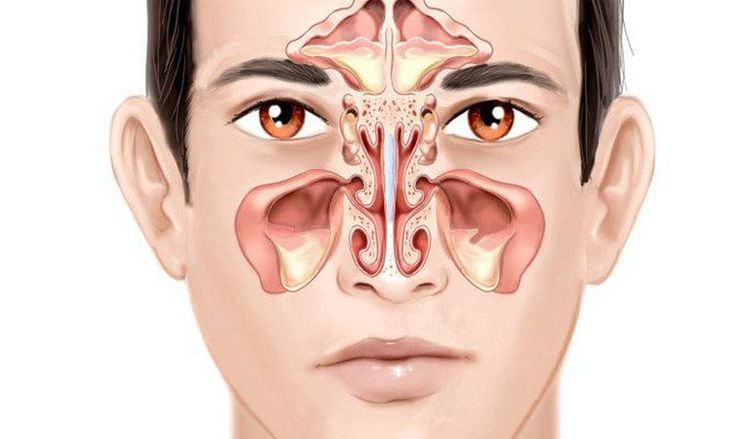
Các nhóm xoang trong có thể con người có vai trò và chức năng riêng biệt
Sinusitis or rhinosinusitis is a condition in which the lining of the sinuses is inflamed due to many causes, this condition causes blockage of the sinus openings, fluid retention in the sinuses.
The causes of sinusitis are many, including:
Sinusitis due to bacterial infections: Usually caused by upper respiratory tract infections, bacteria that cause upper respiratory tract infections, tooth infections. Due to viral infection: Viruses that can cause sinusitis include influenza virus, adenovirus... Fungal sinusitis: Fungus is also a common cause of sinusitis, typical fungal sinusitis is on one side. Allergic sinusitis: Due to the body's exposure to allergens that cause sinusitis. Allergens such as pollen, dental dust, animal hair... Due to anatomical abnormalities: deviated nasal septum, nasal polyps, nasal cavity tumors... Due to endocrine factors: Common in women pregnant, the patient has hypothyroidism.
2. How many types of sinusitis?
2.1 Classification based on the course of the disease Based on the course of the disease, sinusitis is divided into two types:
Acute sinusitis: Sinusitis occurs in a short time, usually responds well to treatment drugs. With good treatment and care, acute sinusitis will completely heal. Chronic sinusitis: Due to untreated acute rhinosinusitis, there are at least 4 recurrent exacerbations causing obstruction of sinus openings, sinuses containing fluid or pus. To treat chronic rhinosinusitis requires drug therapy combined with procedures. Some cases due to anatomical abnormalities require surgery to treat the cause.
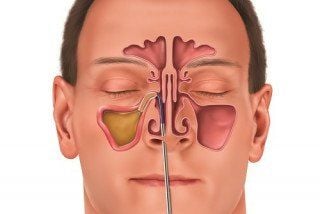
Viêm xoang là tình trạng các xoang chứa dịch hay mủ và cần được sớm điều trị
2.2 Classification according to the location of sinusitis ethmoid sinusitis
The ethmoid sinus is many small cavities, located between the nasal cavity and the eye socket. The ethmoid sinus is the smallest of the sinuses. Due to its complex structure, it is prone to inflammation. Sinusitis is usually divided into the following main forms, including:
Anterior ethmoiditis: In this case, mucus is seen in the anterior and middle slits of the nose, mucus will be stagnant in the nose, causing congestion and pain in the base of the nose. Posterior ethmoid sinusitis: At this time, the mucus will pass through the posterior nasal slit to the nasopharynx, causing discomfort, the patient will have a feeling of entanglement in the throat and the reflex to spit sputum continuously. If the disease is severe, it can cause severe symptoms such as pain at the top of the head, which can affect vision. Inflammation of both ethmoid sinuses: Both anterior and posterior ethmoid sinuses are inflamed causing obstruction of fluid circulation. Patients often have a stuffy nose, runny nose, stagnant sputum in the neck and always want to spit. ethmoid sinusitis in children: ethmoid sinusitis in children often needs to be monitored. Because it can cause many complications such as respiratory infections, sometimes acute complications affect vision, intracranial complications. Need emergency treatment.
Frontal sinusitis
Frontal sinus is a sinus located in the frontal bone, located at the highest position in the facial sinuses, corresponding to the top of the eyebrows. Frontal sinusitis is most common and is often accompanied by anterior ethmoid sinusitis. Some typical symptoms of frontal sinusitis:
Pain and soreness often appear above the eye socket, the eyebrow area The pain tends to increase gradually from morning to midday Heavy pus discharge, after discharge After the epidemic, the pain subsides, but usually in the afternoon it starts to recur. Moving the eyes back and forth sometimes causes pain, pressing the area above the eye socket will feel a sharp pain.
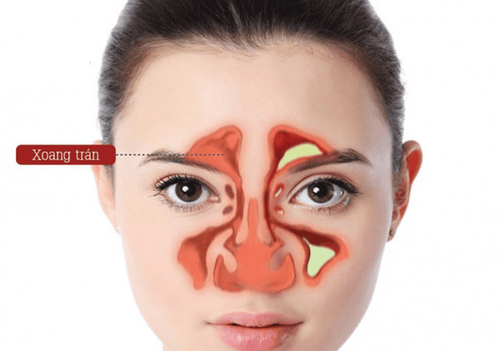
Vị trí viêm xoang trán tại vùng cao nhất trong các xoang ở mặt
Patients often have stuffy nose, runny nose, may have headaches for a long time. Frontal sinusitis can cause complications such as acute otitis media or chronic otitis media, perforation of the tympanic membrane; Due to which frontal sinus is located, there is a risk of purulent meningitis and death if not early intervention
Sphenoid sinusitis The sphenoid sinus is located below the ethmoid of the skull, this is the deepest sinus in the nasal cavity, related to the optic nerve and internal carotid artery.
Some symptoms of sphenoid sinusitis:
Nasal congestion, nasal discharge can be clear, yellow or light green Pain in the middle of the eye sockets, on the top of the head and spreading to the back of the neck The sensitivity of the nose is reduced due to The olfactory nerve is affected May affect vision, cause blurred vision, reduce vision Drainage to the back of the throat is more than other forms of sinusitis, also causes bad breath. Other symptoms can be seen such as fever, otitis media, pharyngitis ... Sphenoid sinusitis symptoms are often unclear, difficult to diagnose the disease.
Maxillary sinusitis
The position of the maxillary sinuses is located right on the cheeks and towards the wings of the nose. This is the largest of the facial sinuses. Manifestations of maxillary sinusitis include:
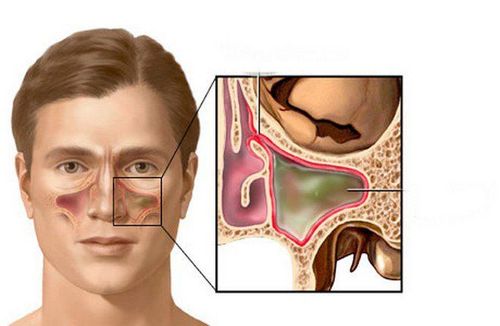
Viêm xoang hàm là tình trạng viêm ổ xoang lớn nhất trong các xoang tại vùng mặt
Patients often have dental problems, often leading to maxillary sinusitis. See a discharge from the nasal passage, causing stuffy nose, runny nose. The discharge may have an unpleasant odor. Pain in both cheeks, pressing on the position of the nasolabial folds feels a lot of pain. When having maxillary sinusitis can lead to some complications such as orbital abscess, spreading to other sinuses. Polysinusitis
Polysinusitis is the term to describe inflammation of many sinuses at the same time. The cause of this pathology can be due to bacterial infection from one sinus to other sinuses, allergies, environmental factors, abnormal anatomical structures, and reduced resistance of the body.
Characteristic symptoms of polysinusitis include:
Nasal discharge lasts a lot, the color may be green or yellow, in many cases there is also blood or pus. Frequent severe headache, pain in the temples, forehead, around the eyes, the top of the head and spreading to the back of the neck. May be accompanied by decreased vision and decreased ability to smell. Tired of not eating well. Mild fever. There is fluid coming out of the throat, so there is always a feeling of entanglement and, uncomfortable in the throat, wanting to spit up phlegm. Above are some characteristics of sinuses and common types of sinusitis. Sinusitis is common, so it is important to pay attention to early treatment to avoid progression to chronic, making it difficult to treat.
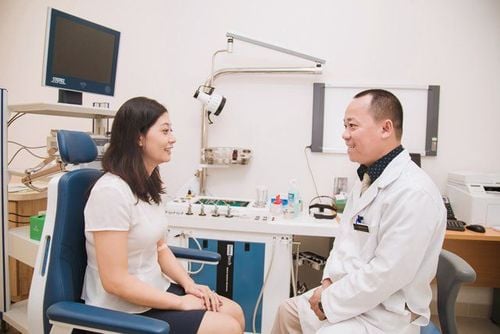
ĐỊnh kỳ kiểm tra sức khỏe Tai Mũi Họng giúp người bệnh sớm được phát hiện bệnh lý và điều trị kịp thời
Vinmec International General Hospital examines and treats common nasopharyngitis diseases, head and neck tumors, congenital malformations of the ear, nose and throat area with the most optimal internal and surgical methods for patients, both children and adults. Coming to Vinmec International General Hospital, patients will receive a direct, dedicated and professional examination from a team of qualified and experienced medical staff.
Please dial HOTLINE for more information or register for an appointment HERE. Download MyVinmec app to make appointments faster and to manage your bookings easily.
SEE MORE
Typical signs of sinusitis Beware of eye complications, headaches due to sinusitis What to do with maxillary sinusitis?





